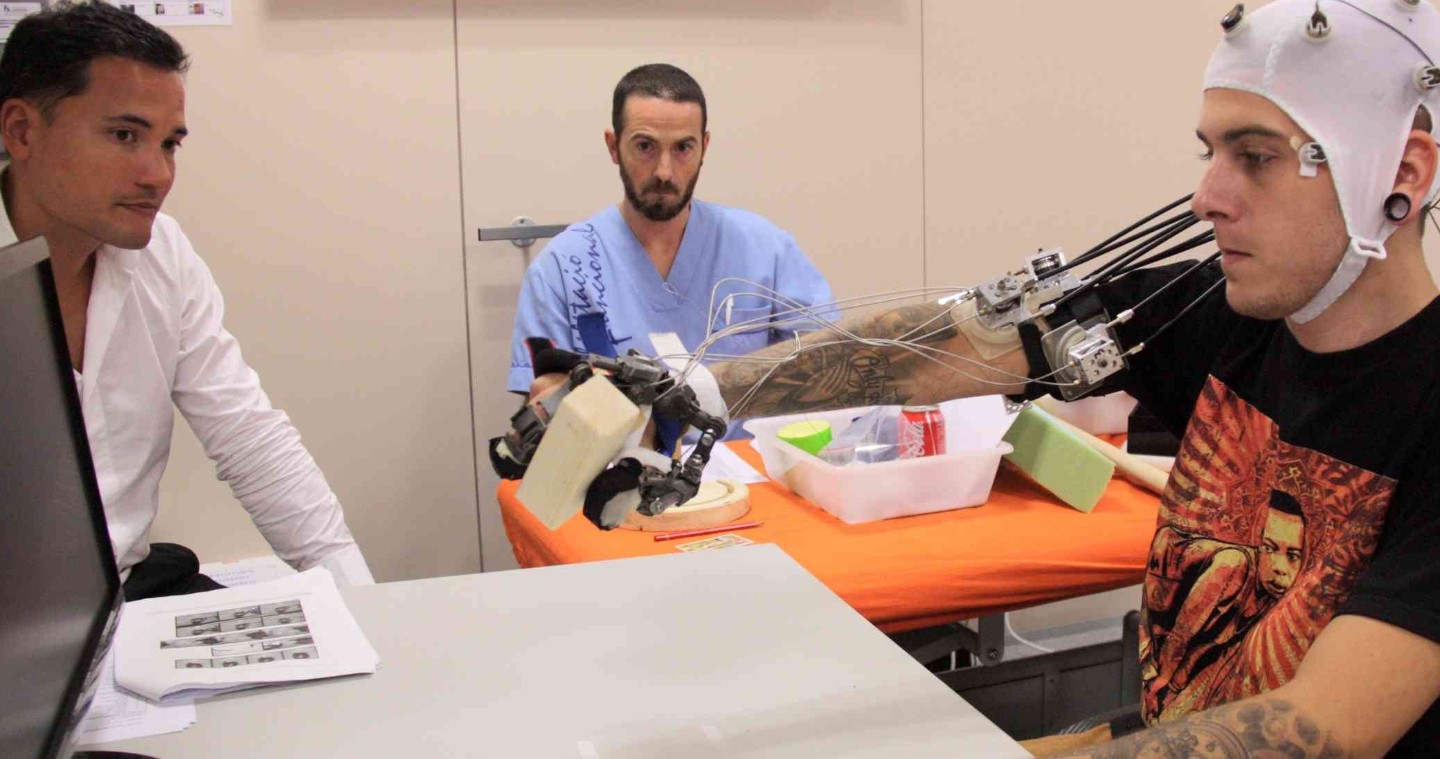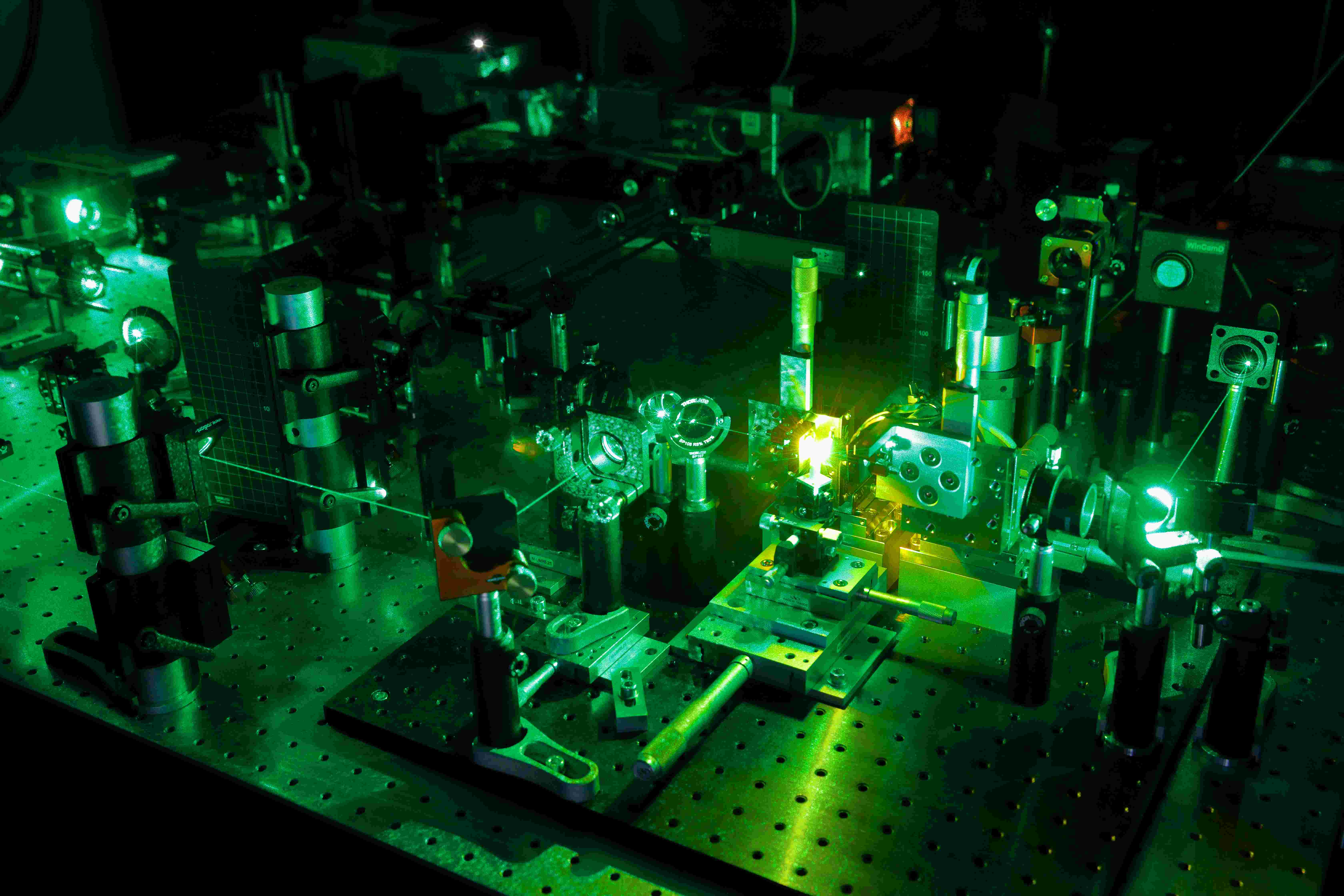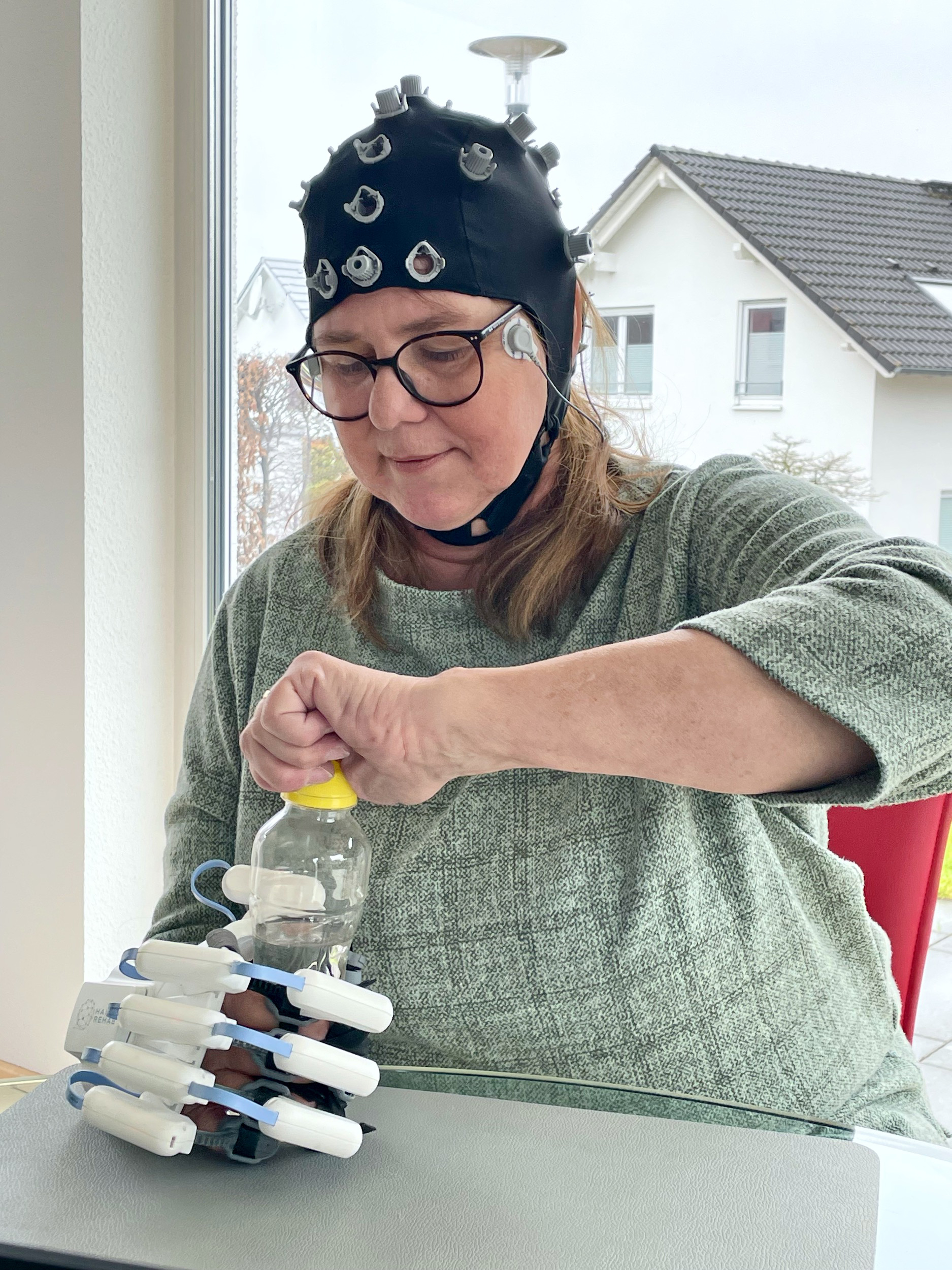NeuroQ project
Quantum sensors for exoskeletons: can quantum physics beat paralysis?
Could people suddenly be able to move again decades after being paralysed? State-of-the-art quantum sensors integrated in exoskeletons could make this possible. Technology being developed as part of the BMBF-funded NeuroQ beacon project by researchers from organisations including the Fraunhofer IAF, the Charité in Berlin and the University of Stuttgart might achieve even more: besides facilitating movement, it could also – in the ideal case scenario – help cure paralysis.
 Patient testing a brain-computer interface developed at the Charité. It is used to control a hand exoskeleton. © Clinical Neurotechnology laboratory, Charité – Universitätsmedizin Berlin
Patient testing a brain-computer interface developed at the Charité. It is used to control a hand exoskeleton. © Clinical Neurotechnology laboratory, Charité – Universitätsmedizin BerlinThe photos in Prof. Dr. Surjo Soekadar’s laboratory at the Charité in Berlin have a touch of science fiction about them. The patient in the photos is wearing a mechanical support known as exoskeleton on his arm. On his head, he has a cap from which numerous wires extend. This headgear is part of an electroencephalogram system (EEG) used to record the patient’s brain activity. The signals are measured and transmitted to the exoskeleton on the arm, which translates this information into movements. Or to put it another way: the man is controlling the exoskeleton with his thoughts.
Science fiction? Far from it. "Research into neural exoskeletons is now happening all over the world; quite a number of patents have already been granted," explains Soekadar. As head of the Division of Translation and Neurotechnology at Charité, he has been working on the topic of neural - i.e. ‘mind-controlled’ - exoskeletons for years and has also developed market-ready systems with his team. "Neural exoskeletons enable people, for example, to use both hands again for everyday tasks after a stroke," says Soekadar. Exoskeletons that enable paraplegics to walk again already exist.
Currently, there is still room for improvement, especially in sensor technology
Exoskeletons work as follows: sensors are attached to the scalp to read brain signals via so-called brain-computer interfaces, BCIs. When a patient thinks about a movement, such as lifting his or her arm, this triggers electrical signals in the brain. Nerve pathways pass these on to the arm, which in healthy people leads to movement. These signalling pathways still function in paralysed people, with the difference that a paralysed person’s body is no longer able to convert them into action. A neural exoskeleton can overcome this. The brain-computer interface sensors measure the brain signals, which are then converted by a computer for the exoskeleton to translate into movement.
As impressive as this progress is, the technology is still a long way from enabling paraplegics to go for a walk or grasp objects using exoskeletons. The current models for walking resemble clumsy, heavy robotic suits or aids. Exoskeleton arms and hands can perform basic movements, but are not yet able to execute fine motor movements like grasping a cup. What’s more, most exoskeletons only work under laboratory conditions, as currently used sensors are extremely prone to failure. And their biggest drawback is that the brain-computer interfaces used to control complex movements require risky surgery to implant the sensors into the head.
Quantum sensors render surgery superfluous
 Dr. Jan Jeske, deputy business unit manager quantum devices at Fraunhofer IAF © Fraunhofer IAF
Dr. Jan Jeske, deputy business unit manager quantum devices at Fraunhofer IAF © Fraunhofer IAFThis is now about to change. Several leading German research institutions have joined forces in the NeuroQ project to develop new sensors that could solve the issues associated with neural exoskeletons. NeuroQ project participants include the Fraunhofer IAF in Freiburg, the Charité in Berlin, the University of Stuttgart and various companies.
The goal of the five-year project is to develop quantum sensors that are sensitive enough to interpret brain activity even when they are just touching the scalp. This would make surgery superfluous. One idea is to integrate the sensors into a removable headband.
The transmission of brain signals is also expected to function so precisely in the future that even the finest motor skills, such as grasping small objects, will be possible and will work outside the laboratory. And perhaps even more will be possible: numerous studies suggest that the technology can help cure severe and chronic paralysis.
"I think that quantum sensor technology will have a major impact on industry and in medical technology in the next ten to twenty years, including from measurement technologies to imaging techniques," says Dr. Jan Jeske, deputy business unit manager quantum devices at Fraunhofer IAF. Jeske also believes that quantum sensors will have enormous advantages when used in brain-computer interfaces. He attributes this to the fact that brain activity emits both electric and magnetic fields. Current sensors mostly focus on electrical signals, but the quantum sensors developed in NeuroQ focus on magnetic fields. "Unlike electrical signals, magnetic fields are not attenuated by the cranial bone and thus have the potential to distinguish detail much more than electrical sensors can," the researcher explains. In other words, surgery will no longer be required because quantum sensors provide more accurate measurements than EEG systems.
How quantum sensors work
 Quantum sensor development at Fraunhofer IAF. © Fraunhofer IAF
Quantum sensor development at Fraunhofer IAF. © Fraunhofer IAFNeuroQ’s quantum sensors use artificial diamonds, lasers and radio waves to measure the magnetic field. This is how it works: the artificial diamonds contain so-called nitrogen-vacancy (NV) centres. These NV centres behave like tiny magnets and are sensitive to magnetic fields in their environment. To measure these magnetic fields, a green laser and radio waves are directed at the diamond, exciting the NV centres. These absorb the green laser light and emit red light. The intensity of this red light depends on the magnetic field acting on the NV centres.
The diamond-based quantum sensors can thus also measure the magnetic fields produced by the brain during thinking – and do so with greater accuracy than current sensor types. Exoskeletons could therefore be controlled much more precisely than before, making fine motor skills possible for the first time. What's also particularly important for patients is that diamond-based quantum sensors carry on measuring reliably even in the presence of other background fields. "This means that in future they could be used elsewhere than in laboratory settings," Jeske explains.
The potential of quantum sensors in medicine is enormous
 This stroke patient at Charité has had a completely paralysed right hand since the age of 18. In the photo, she is controlling an exoskeleton with the power of her thoughts. Currently, she is only able to open and close the hand. With NeuroQ sensors, she should be able to move individual fingers as well. © Niels Peekhaus / Clinical Neurotechnology, Charité – Universitätsmedizin Berlin
This stroke patient at Charité has had a completely paralysed right hand since the age of 18. In the photo, she is controlling an exoskeleton with the power of her thoughts. Currently, she is only able to open and close the hand. With NeuroQ sensors, she should be able to move individual fingers as well. © Niels Peekhaus / Clinical Neurotechnology, Charité – Universitätsmedizin BerlinBoth Jeske and Soekadar have numerous ideas about how quantum sensors could be used in medicine in future. The researchers want to use the NeuroQ project to improve exoskeletons and enable their broader use. What’s next? There are numerous options. "It might, for example, be possible to use quantum sensors during operations to detect the finest nerves, and avoid accidentally cutting through them," Jeske says. "It might also be possible to replace current MRI sensors and improve magnetic resonance imaging."
Another exciting scenario could be the rehabilitation of paralysed patients. Here, using neural sensors and exoskeletons to activate muscles results in a feedback loop with far-reaching consequences. "We used this procedure on stroke patients, thinking let’s see whether this works or not," Soekadar says. "After a month, the patients, some of whom had been paralysed for many years or even decades, were suddenly able to move their hand again on their own. The technique could be used in a wide variety of areas, from paralysis to treating mental illnesses such as depression, addiction or obsessive-compulsive disorders."
In the long term, the technique might render expensive exoskeletons for home use obsolete. The neuroscientist comments: "The goal is to get to a point where the brain interface is not required at all: patients would recover by regularly using the brain-computer interface but in the long term would no longer need the technology at all. For me, this would be the best possible result."
Project partners:
- Fraunhofer Institute for Applied Solid State Physics, IAF, Freiburg
- 3rd Physics Institute, University of Stuttgart
- Clinical Neurotechnology laboratory at Charité - Universitätsmedizin Berlin
- Twenty-One Semiconductor GmbH, Neckartenzlingen
- Sacher Lasertechnik GmbH, Marburg
- Advanced Quantum, Allmersbach im Tal
- W+R Schirmungstechnik GmbH, Rheinstetten
- neuroConn GmbH, Ilmenau
- NIRx Medizintechnik GmbH, Berlin